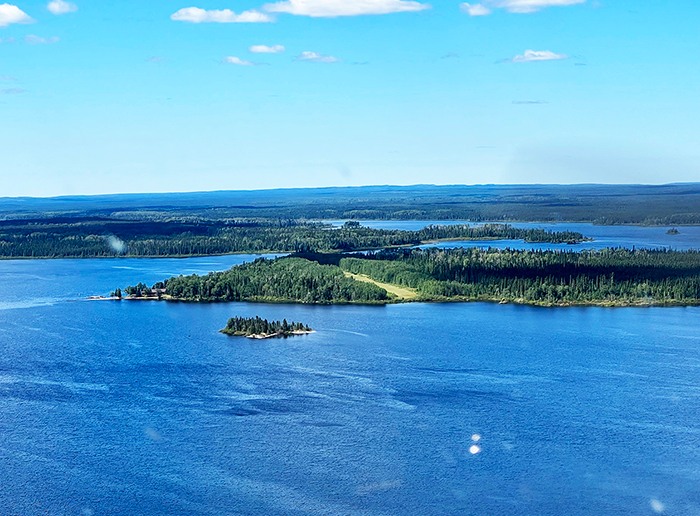
Pete Aarsvold Photo
by Dave Weiman
Published in Midwest Flyer Magazine October/November 2022 Digital Issue
I last flew to Canada on what was then our annual Canada Fishing Fly-Out to Miminiska Lodge, Ontario (CPS5) in 2019, and then the pandemic hit. Travel outside the U.S. and Canada came to a sudden halt. Then in 2021, there was a glimmer of hope that we could reinstate the trip, but the light all but went out when Canada closed its Customs Office at Thunder Bay International Airport, and there were added COVID-19 testing requirements. Had we gone, we would have to fly to either Winnipeg or Toronto to clear Canada Customs, hundreds of miles out of our way to our destination in northern Ontario. We would have also had to land at Armstrong, Ontario – 79 miles south of Miminiska – then fly to one of the other lodges owned by Wilderness North, by floatplane, as Miminiska was closed, and is the only lodge owned by Wilderness North that has an airstrip – a pretty unique feature for any Canada fishing destination.
So, our 2022 trip this year was the first time since 2019 we could fly to Miminiska Lodge and were we ever excited!
Accompanying me on this year’s trip, August 8 – 13, 2022, was Michael J. “Mick” Kaufman, who writes our “Instrument Flight” column in Midwest Flyer Magazine.
With my Cessna 182 Skylane washed, waxed, fueled, and loaded the night before, I filed our eAPIS (electronic Advance Passenger Information System) departure from the U.S. and arrival from Canada flight manifests; uploaded my COVID-19 Vaccination Record Card via a new app called “ArriveCAN,” which is now required for anyone who travels to Canada; called Canada Customs (1-888-CAN-PASS, 226-7277) and gave them our ETA to Thunder Bay (CYQT); then departed Richland Center, Wisconsin (93C). We filed our instrument flight plan to Thunder Bay via Duluth and leveled off above partly cloudy skies at 8,000 MSL.

Months before the trip, I ordered and obtained my 2022 U.S. Customs & Border Protection “aircraft decal” online at https://dtops.cbp.dhs.gov.
When giving either U.S. or Canada Customs your ETA, you are supposed to arrive within plus or minus 15 minutes, which requires pilots to consider runup time prior to takeoff, time en route, and taxi time at their destination. We arrived on the ramp right on time, and so were the Canada Customs officials who met us at our aircraft.
In providing our ETAs with Customs, we needed to remember that both Thunder Bay and Miminiska Lodge, Ontario are in the Eastern Time Zone, while Minnesota and Pickle Lake, Ontario are in the Central Time Zone. It would be easier for pilots if U.S. and Canada Customs went by Zulu Time, but they don’t. It would also help if all Customs offices used aircraft tracking tools, such as “FlightAware,” so they know exactly when we will be arriving.
U.S. Customs & Border Protection (CBP) requires that pilots confirm their ETA at their airport of entry as filed on their flight manifest at least 1 hour prior to their ETA, or prior to departing the U.S., then update it as necessary.
CBP states: “If changes to an already transmitted manifest are necessary, an updated and amended manifest must be submitted to CBP. Only amendments regarding flight cancellations, expected time of arrival (ETA) or changes in arrival location to an already transmitted manifest may be submitted telephonically, by radio, or through existing processes and procedures and should be coordinated directly with the CBP destination port.” If you change the “date” of your arrival, passengers, or crew, you must submit a new flight manifest.
Packing for the trip requires considerable planning. You want to bring enough stuff, but not too much! We packed essential equipment for the aircraft including extra oil, basic tools, a tie-down kit, and an aircraft canopy cover; survival equipment and gear, including inflatable life vests which we wore during the flight and in our boat, a personal locator beacon (PLB), first aid kit, compact tent, food and water, and warm clothes. Some pilots also bring a shot gun or rifle for personal protection in the event of an off-field landing.
To transport a firearm, the Royal Canadian Mounted Police requires pilots to complete a non-resident firearm declaration form (RCMP 5589) and pay a modest fee. There are also requirements for trigger locks and ammo stowage. Whenever I transport a firearm into the bush, I position it in the aircraft within easy reach of the pilot’s seat. Handguns are forbidden in Canada.
For pilots who choose to fly over the Great Lakes (which we do not encourage), a life raft and dry suits are recommended, as is training in water ditching survival.
Of course, what kind of a fishing trip would be complete without “fishing tackle” (breakdown rods and cases recommended), a rain suit, and a hat. And don’t forget sunscreen, insect repellant and mosquito netting headgear.
A copy of the “Canada Flight Supplement” and navigational charts are a must, even though most pilots nowadays use iPads with “ForeFlight” for flight planning and navigation, and most aircraft are equipped with GPS. Be sure your ForeFlight subscription includes Canada. The ForeFlight “Pro Plus Canada and USA” does.
Yes, it gets to be a lot of stuff. That’s why we encourage pilots in our group to fly two people per four-place aircraft, and complete “weight and balance” computations for their aircraft. Planning one’s fuel stops is also essential because airports can be far and few between.
Knowing that we would either be on a flight plan or flight itinerary, and that Canada has one of the best search and rescue organizations in the world, was reassuring.
To cross the U.S. and Canada border, pilots must either be on a VFR or IFR flight plan, obtain a transponder squawk code from Center or Flight Service, and be on frequency with one or the other. The simplest way to fulfill all three requirements is to be on an IFR flight plan. When returning to the U.S. from Canada, pilots are required to follow the same procedure: file and activate a flight plan, obtain a squawk code, and be on frequency.
Radar and radio coverage in northeast Minnesota is sparse, especially at lower altitudes, but as we proceeded to Thunder Bay on our IFR flight plan, we had a transponder code and Minneapolis Center knew our route of flight, our last known position, groundspeed, and ETA to Thunder Bay, even though we were no longer on radar. Once 50 miles or so southwest of Thunder Bay, we contacted Thunder Bay Arrival (Approach Control) and they picked us up on radar.
Customs officials in both the U.S. and Canada want to see your pilot certificate, passport, ArriveCAN receipt, and the passports and ArriveCAN receipts for each crew member and passenger. It is also good to have your medical certificate and aircraft registration available should officers request them. The Canadian government also requires that pilots have a “certificate of insurance” proving liability coverage, and a “Radio-Telephone Operator’s Permit,” and a “Radio Station License” for your aircraft, but in all the years I have been flying to Canada, Canada Customs has not requested these documents.
Upon landing, when you speak with either the Canada Customs officer in person or on the telephone, the officer will give you a “clearance report number” which you should keep in your possession throughout your stay. You should also request the officer’s badge number to document who you spoke with or met. For the return flight back to the United States, U.S. Customs will not give you a clearance report number, so be sure to get the badge number of the officer you meet with at your airport of entry, as this will be the only proof you will have that you actually cleared Customs.
It is not unusual that Canada Border Services (CBS) officers are not present upon your arrival, especially if you arrive past normal business hours or on weekends. In these circumstances, the pilot-in-command may get out of his aircraft and go inside the fixed base operation to call 888-CAN-PASS to clear Customs. Thanks to cell phones and extended coverages, it is easier just to give Canada Customs a call from your aircraft, so once cleared, your crew and passengers can also leave the aircraft. Remember that neither you as pilot-in-command – nor your passengers – may get out of your aircraft when you return to the U.S., until you are met by a U.S. Customs officer, and he gives you the okay.
Once we cleared Customs in Thunder Bay, the fixed base operator fueled us, and we called the Wilderness North office to activate our “flight itinerary” to Miminiska Lodge. Wilderness North then notified Miminiska Lodge of our ETA via email or WiFi telephone. (See Transport Canada Regulations 602.73 thru 602.77.)
In Canada, pilots are required to file a flight plan if flying 25 miles beyond their departure airport, unless someone at their destination airport is expecting them, and can contact Winnipeg Flight Service (FSS) to initiate search and rescue if they do not show up within 1 hour of their ETA. But a flight plan is only as good as the radio reception or telephone at your destination, so you can cancel it upon your arrival.
Aside from a strong crosswind at Thunder Bay, the weather was excellent all the way to Miminiska Lodge.
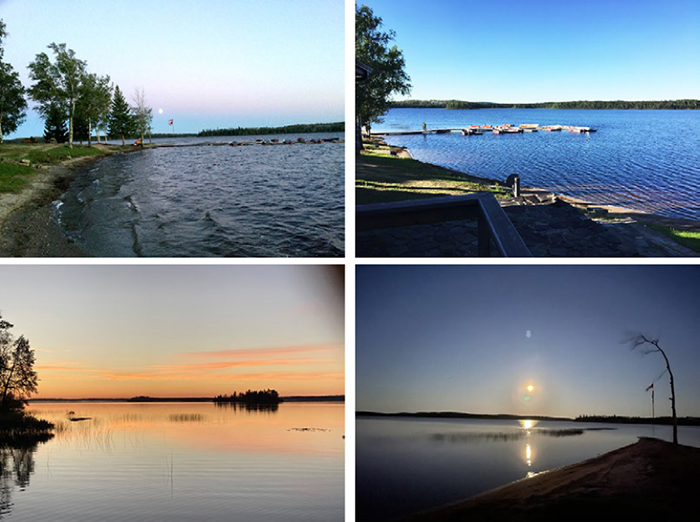
We were flying by ourselves that day, but whenever there are two or more aircraft flying together, we encourage pilots to stay in radio contact with one another on 122.75 Mhz and give position reports to one another along the way. ADS-B and ForeFlight have been fantastic regarding keeping track of one another enroute. We also monitor 126.7 Mhz, as that is the frequency used in Canada for pilot reports. And on a good day, depending on your altitude and position, you can reach Winnipeg Flight Service on that frequency, and on several others. Refer to the Canada Flight Supplement and navigation charts for frequencies, airport information and much more!
When we arrived at the lodge, visibility was unrestricted, and the wind was straight down the runway as noted by both the Canada and U.S. flags on the sand point south of the lodge, and the waves on the water.
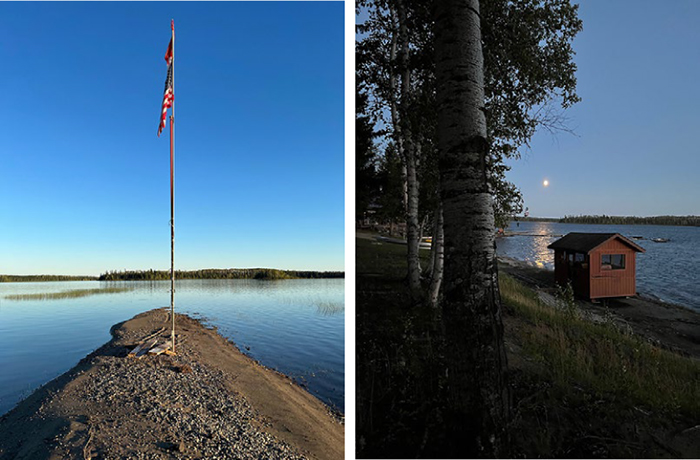
Based on the information contained in the Canada Flight Supplement, the elevation at Miminiska Lodge (CPS5) is approximately 1000 feet ASL (Above Sea Level), so we used 2000 feet ASL as our pattern altitude; 122.8 Mhz as the common traffic advisory frequency (CTAF); and began making position announcements 5 nm out below 4000 feet ASL.
We had several Cessnas and Beechcraft aircraft, and one Piper and one Cirrus in our group. In all, we had nine aircraft and 19 guests.
Upon our arrival, the lodge manager called or emailed back to the Wilderness North Office to cancel our flight itinerary.
Miminiska Lodge
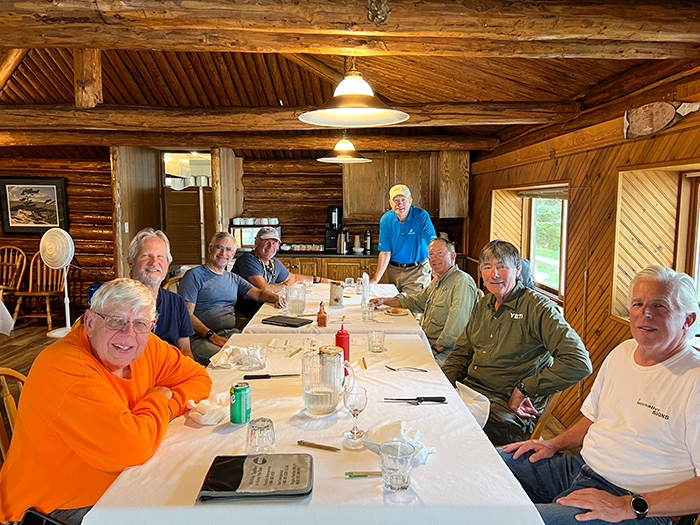
Very few Canada fishing lodges have their own airstrips, and fewer are as remote as Miminiska, located 62 nautical miles from any roads. This makes Miminiska especially appealing to pilots and true outdoorsmen.
Miminiska Lodge features a rustic dining room overlooking the lake; a lounge for kicking back and relaxing; a full bar, billiard room, and big screen satellite television; and Wi-Fi internet as noted earlier. There is also a sauna by the lake, and canoes, kayaks, and paddle boards are available for your enjoyment.
Most of the pilots and their passengers this year had been on the trip before, but new people are always welcomed! There are several trips spread out over two weeks in August that are eligible for the special group rates.
The fishing was unbelievable this year for both Walleye and Northern Pike, as they had 3 years to grow and multiply.
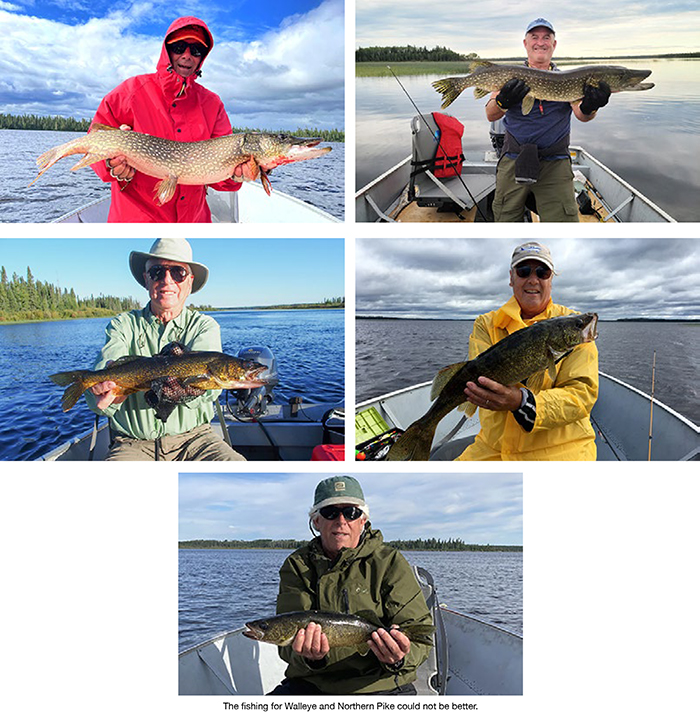
The water level was up, so most rocks were submerged and did not present a problem boating. Still, boat insurance is included with our group rates.
All meals were professionally prepared, including shore lunch.
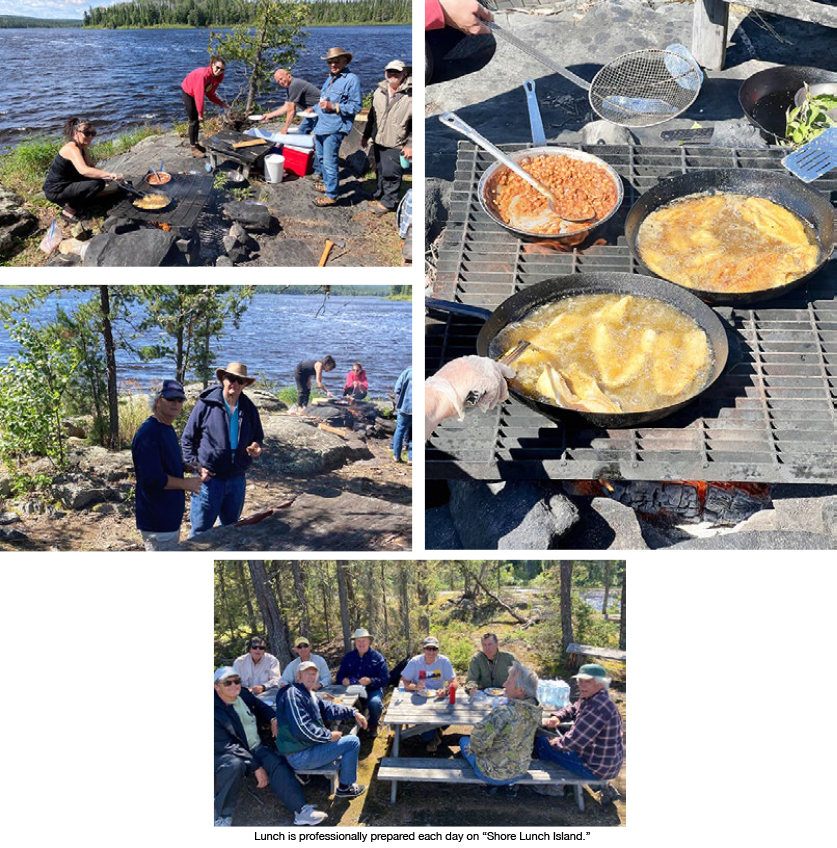
Breakfast is served at 7:00 a.m. or whenever you get up. Group shore lunch is at noon, but guests have the option of packing a lunch for those longer trips on the lake.
The evening reception begins at 5:30 p.m., and dinner is served at 6:00 p.m. If requested, a fresh pot of coffee is delivered to your cabin each morning, and thermoses and coolers can be delivered to your boat for your morning launch. From the dining room to the docks, the staff at Miminiska Lodge is the best!
Located on the Albany River Watershed in northwest Ontario, Miminiska Lodge offers guests the opportunity to experience the raw beauty of pristine boreal wilderness. Northern Pike and Walleye are caught in abundance. Brook Trout can be caught at the mouth of the Albany River. Loons, Eagles and an occasional Moose, Caribou or Bear can be seen.

There are three ways to effectively catch fish at Miminiska Lodge – trolling, jigging, and casting.
Trolling crankbaits is a good way to cover a large body of water and locate concentrations of Walleye and Northern Pike. Good baits are #7 and #9 fire tiger and purple tiger Flicker Shads, neon yellow and orange Perch Pattern Shads, and orange and gold Rapala Shad Raps and similar crankbaits that run 8-12 feet below the surface. Jointed Rapalas are good for shallower depths and attract both species of fish.
Jigging over structure is a traditional way of catching Walleye and the unsuspecting Northern Pike. For jigging, we used 1/8th and 1/4-ounce jigs in a variety of colors with Mister Twister Tails in chartreuse or white. Jigs with any variety of artificial Gulp minnow, worm or leaches also work extremely well. You can buy leeches through Wilderness North, but they must be ordered in advance. You cannot bring live bait into Canada from the U.S. You are also not allowed to transport fresh fruit and vegetables from one country to the other.
Casting copper or silver spoons in the bays is always effective for Northern Pike. Casting crank baits on a wind-blown shore is usually productive for Walleye.
As for fishing rods, I take two rods and several reels: one medium weight rod for Walleyes and one heavy weight rod for Northerns. If you don’t have a heavy weight rod, two medium weight rods will work, as well.
Wilderness North will obtain Ontario fishing licenses and outdoors cards for guests upon request, as well as any special beverages and provisions desired.
Anything you order in advance will be waiting for you upon your arrival. And when you are ready to depart, any fish you have caught to take home are cleaned, filleted, froze, and placed in the cooler you brought with you on the trip.
Guests are allowed to keep two fish of each species: Northern Pike under 27 inches in length, and Walleyes under 18 inches. This is a conservation policy which helps to maintain a superb fishery.
The lodge provides 16 ft. Lund boats with 25 hp, 4-stroke, electric start Yamaha motors and fish finders.
Guides are available but are not necessary for guests who have navigated the waters before, but are highly recommended for newcomers and inexperienced fishermen.
The lodge has a detailed map of the watershed showing where to catch each species of fish, but due to changes in water temperature and levels, fish locations can vary. Regardless, there was plenty of action for everyone, and we never went hungry at shore lunch.
For those who want to take a break from fishing, there are waterfalls on one end of the river you can hike to see, an old gold mining camp, and Church Island, where there is a small church you can visit and sign the guest book. Outside the church is the grave of the last native priest to have held services there. Miminiska Lodge also offers one-day excursions for Brook Trout fishing and canoeing on nearby rivers. For those preplanned trips, guests are usually flown out on a de Havilland DHC-2 Beaver on straight floats.
Our Flight Home
Guests on the Canada Fishing Fly-Out to Miminiska Lodge have their choice of either a three-night/two-day trip, four-night/three-day trip, or five-night/four-day trip, so our arrival and departure days can vary somewhat, as can our routes of flight to and from the lodge. Some of us file IFR flight plans and others, VFR flight plans or flight itineraries, and clear U.S. Customs in either Duluth or International Falls, Minnesota; Sault Ste. Marie, Michigan; Green Bay, Wisconsin; or elsewhere.
Since Miminiska Lodge is 196 nm north of Thunder Bay, pilots need to climb to 10,000 feet MSL and be within 100 nm of the Canada/U.S. border before they can reach Winnipeg Center outbound from Miminiska. However, your flight plan is automatically activated as per the proposed time of departure specified. Obviously, this can pose a problem if you do not depart as planned. You can confirm your actual departure time with Winnipeg Flight Service shortly after takeoff once you reach altitude.
If you choose instead to fly 62 nm west to Pickle Lake, Ontario (CYPL) for fuel, you can either file a flight itinerary through Wilderness North at the lodge, then call the office upon your arrival to cancel it. The office will then notify the lodge that you have arrived safely. Thanks to WiFi service at the lodge and ForeFlight, pilots have the option of filing either a VFR or IFR flight plan with Winnipeg Flight Service to Pickle Lake or elsewhere, and from Pickle Lake, Thunder Bay Radio will activate your flight plan when you depart. It is always best to confirm that Thunder Bay Radio has activated your flight plan. I am very impressed with the ability of specialists at Thunder Bay Radio to be able to coordinate air traffic remotely and do so without any radar or visual contact. And it is certainly more economical than having to man each airport. Thunder Bay Radio at Pickle Lake can be reached on 122.2 Mhz and must be contacted before entering the circuit (traffic area) within 5 nm at 4300 ASL or below. Again, refer to the Canada Flight Supplement for current airport information.
The advantage of flying to Pickle Lake before flying to your U.S. airport of entry, is that you can call U.S. Customs to confirm or update your ETA.
Once airborne on our departure from Pickle Lake, Thunder Bay Radio advised us to contact Winnipeg Center on a particular frequency, 150 miles north of International Falls. But while we could hear Center on frequency at that distance at our altitude of 6000 feet MSL, they could not hear us until we were about 75 miles north of International Falls. We were unable to reach Minneapolis Center until we were 30 miles from International Falls.
2023 Canada Fishing Fly-Out
The dates and trip options for the 2023 Canada Fishing Fly-Out to Miminiska Lodge will be announced soon. For special group rates, email me at dave@midwestflyer.com.
For reservations, call Wilderness North toll free at 888-465-3474, and be sure to check out the Wilderness North website: www.wildernessnorth.com. There’s even a special section on the website for pilots like us who fly their own aircraft to the lodge.
Some people go on this trip for the fishing, and others for the adventure of the flight, but most go for the total experience and pilot camaraderie, and to reinvigorate oneself, meet new people, and reconnect with old friends!
EDITOR’S NOTE: The Canada Fishing Fly-Out to Miminiska Lodge has been featured on the national aviation radio program, the “World of Aviation” on Minneapolis AM 1280 and FM 107.5: https://am1280thepatriot.com/radioshow/world-of-aviation. See 05/15/22 program featuring Dave Weiman. The trip was also featured in the May 2022 issue of American Bonanza Society Magazine in an article written by ABS President, Greg Stratz. Stratz has been participating on the trip for more than a decade.
The flyout is a service of Wilderness North. Neither Midwest Flyer Magazine, Flyer Publications, Inc., nor their staffs and owners, or anyone else affiliated with the magazine, assume any responsibility for reliance on the information contained herein or elsewhere, or liability for anyone’s participation on the trip or for the trip itself. Any flight planning and navigational information mentioned in this article or elsewhere is subject to change and error, and is the responsibility of the reader to research, verify and confirm. Pilots are urged to reference the Canada Flight Supplement, Canada Navigational Charts, Nav Canada and Federal Aviation Administration publications and resources, and the various electronic data bases, such as ForeFlight, to obtain and confirm information.
EDITOR’S NOTE: Photos by Pete Aarsvold, Greg Stratz, Patrick Williams, Bob Metelko, Rick Bronecki, Gary Bulzan, Scott Alperin, Rex White, Eric Workman, Dave Weiman and the staff at Miminiska Lodge.